Effects of Urbanization on Changes in Precipitation Extremes in Guangdong-Hong Kong-Macao Greater Bay Area, China
Abstract
:1. Introduction
2. Material and Methods
2.1. Study Area
2.2. Data Source
2.2.1. Data for Urbanization Level Extraction
2.2.2. Data for Extreme Precipitation Detection
2.3. Methods
2.3.1. Extreme Precipitation Indices
2.3.2. Theil-Sen Estimator and Mann-Kendall Trend Test
2.3.3. Mann-Kendall Mutation Test
2.3.4. Bivariate Moran’s I
2.3.5. Spearman Correlation Coefficient
3. Results and Discussion
3.1. Urbanization Development in the GBA
3.2. Characteristics of Extreme Precipitation
3.2.1. Spatio-Temporal Distribution of EPIs
3.2.2. Spatio-Temporal Variations of EPIs
3.3. Association between EPIs and Urbanization
3.3.1. The Spatial Correlation between EPIs and Urbanization
3.3.2. The Correlation between EPIs and Urbanization in Time Scale
3.4. Discussion
3.4.1. Changes of Extreme Precipitation at Different Urbanization Stages
3.4.2. Influence of Urbanization on Extreme Precipitation at Different Urbanization Stages
4. Conclusions
Author Contributions
Funding
Data Availability Statement
Conflicts of Interest
References
- Abbott, B.W.; Bishop, K.; Zarnetske, J.P.; Minaudo, C.; Chapin, F.; Krause, S.; Hannah, D.M.; Conner, L.; Ellison, D.; Godsey, S.E. Human domination of the global water cycle absent from depictions and perceptions. Nat. Geosci. 2021, 12, 533–540. [Google Scholar] [CrossRef]
- Douville, H.; Raghavan, K.; Renwick, J.; Allan, R.P.; Arias, P.A.; Barlow, M.; Cerezo-Mota, R.; Cherchi, A.; Gan, T.; Gergis, J.; et al. Water cycle changes. In Climate Change 2021: The Physical Science Basis. Contribution of Working Group I to 45 the Sixth Assessment Report of the Intergovernmental Panel on Climate Change; Cambridge University Press: Cambridge, UK, 2021. [Google Scholar]
- Ingram, W. Increases all round. Nat. Clim. Chang. 2016, 6, 443–444. [Google Scholar] [CrossRef]
- Najibi, N.; Devineni, N. Recent trends in the frequency and duration of global floods. Earth Syst. Dynam. 2018, 9, 757–783. [Google Scholar] [CrossRef]
- Zhang, W.; Villarini, G.; Vecchi, G.A.; Smith, J.A. Urbanization exacerbated the rainfall and flooding caused by hurricane Harvey in Houston. Nature 2018, 563, 384–388. [Google Scholar] [CrossRef]
- Su, B.; Huang, J.; Fischer, T.; Wang, Y.; Kundzewicz, Z.W.; Zhai, J.; Sun, H.; Wang, A.; Zeng, X.; Wang, G. Drought losses in China might double between the 1.5 C and 2.0 C warming. Proc. Natl. Acad. Sci. USA 2018, 115, 10600–10605. [Google Scholar] [CrossRef] [PubMed]
- Douris, J.; Kim, G. The Atlas of Mortality and Economic Losses from Weather, Climate and Water Extremes (1970–2019); WMO: Geneva, Switzerland, 2021. [Google Scholar]
- Tellman, B.; Sullivan, J.; Kuhn, C.; Kettner, A.; Doyle, C.; Brakenridge, G.; Erickson, T.; Slayback, D. Satellite imaging reveals increased proportion of population exposed to floods. Nature 2021, 596, 80–86. [Google Scholar] [CrossRef] [PubMed]
- Liu, B.; Chen, S.; Tan, X.; Chen, X. Response of precipitation to extensive urbanization over the Pearl River Delta metropolitan region. Environ. Earth Sci. 2021, 80, 9. [Google Scholar] [CrossRef]
- Donat, M.G.; Lowry, A.L.; Alexander, L.V.; O’Gorman, P.A.; Maher, N. More extreme precipitation in the world’s dry and wet regions. Nat. Clim. Chang. 2016, 6, 508–513. [Google Scholar] [CrossRef]
- Eyring, V.; Gillett, N.P.; Achutarao, K.; Barimalala, R.; Barreiro Parrillo, M.; Bellouin, N.; Cassou, C.; Durack, P.J.; Kosaka, Y.; McGregor, S.; et al. Climate Change 2021: The Physical Science Basis. Contribution of Working Group I to the Sixth Assessment Report of the Intergovernmental Panel on Climate Change; IPCC Sixth Assessment Report; Cambridge University Press: Cambridge, UK; New York, NY, USA, 2021. [Google Scholar]
- Haas, J.; Ban, Y. Urban growth and environmental impacts in jing-jin-ji, the yangtze, river delta and the pearl river delta. Int. J. Appl. Earth Obs. Geoinf. 2014, 30, 42–55. [Google Scholar] [CrossRef]
- Seto, K.C.; Guneralp, B.; Hutyra, L.R. Global forecasts of urban expansion to 2030 and direct impacts on biodiversity and carbon pools. Proc. Natl. Acad. Sci. USA 2012, 109, 16083–16088. [Google Scholar] [CrossRef]
- Wang, Y.; Xie, X.; Liang, S.; Zhu, B.; Yao, Y.; Meng, S.; Lu, C. Quantifying the response of potential flooding risk to urban growth in Beijing. Sci. Total Environ. 2019, 705, 135868. [Google Scholar] [CrossRef] [PubMed]
- Du, H.; Wang, D.; Wang, Y.; Zhao, X.; Qin, F.; Jiang, H.; Cai, Y. Influences of land cover types, meteorological conditions, anthropogenic heat and urban area on surface urban heat island in the Yangtze River Delta Urban Agglomeration. Sci. Total Environ. 2016, 571, 461–470. [Google Scholar] [CrossRef] [PubMed]
- Kennedy, C.A.; Stewart, I.; Facchini, A.; Cersosimo, I.; Mele, R.; Chen, B.; Uda, M.; Kansal, A.; Chiu, A.; Kim, K.-G. Energy and material flows of megacities. Proc. Natl. Acad. Sci. USA 2015, 112, 5985–5990. [Google Scholar] [CrossRef]
- Pielke, R.A., Sr. Land use and climate change. Science 2005, 310, 1625–1626. [Google Scholar] [CrossRef] [PubMed]
- Shepherd, J.M.; Burian, S.J. Detection of urban-induced rainfall anomalies in a major coastal city. Earth Interact. 2003, 7, 1–17. [Google Scholar] [CrossRef]
- Yao, R.; Zhang, S.; Sun, P.; Dai, Q.; Yang, Q. Estimating the impact of urbanization on non-stationary models of extreme precipitation events in the Yangtze River Delta metropolitan region. Weather Clim. Extremes 2022, 36, 100445. [Google Scholar] [CrossRef]
- Huff, F.A.; Changnon, S., Jr. Climatological assessment of urban effects on precipitation at St. Louis. J. Appl. Meteorol. Climatol. 1972, 11, 823–842. [Google Scholar] [CrossRef]
- Kong, F.; Wang, Y.; Fang, J.; Lu, L. Spatial Pattern of Summer Extreme Precipitation and Its Response to Urbanization in China (1961–2010). Resour. Environ. Yangtze Basin. 2018, 27, 996–1010. (In Chinese) [Google Scholar]
- Deng, Z.; Wang, Z.; Wu, X.; Lai, C.; Liu, W. Effect difference of climate change and urbanization on extreme precipitation over theGuangdong-Hong Kong-Macao Greater Bay Area. Atmos. Res. 2023, 282, 106514. [Google Scholar] [CrossRef]
- Kalnay, E.; Cai, M. Impact of urbanization and land-use change on climate. Nature 2003, 423, 528–531. [Google Scholar] [CrossRef]
- Pathirana, A.; Denekew, H.B.; Veerbeek, W.; Zevenbergen, C.; Banda, A.T. Impact of urban growth-driven landuse change on microclimate and extreme precipitation—A sensitivity study. Atmos. Res. 2014, 138, 59–72. [Google Scholar] [CrossRef]
- Paul, S.; Ghosh, S.; Mathew, M.; Devanand, A.; Karmakar, S.; Niyogi, D. Increased spatial variability and intensification of extreme monsoon rainfall due to urbanization. Sci. Rep. 2018, 8, 3918. [Google Scholar] [CrossRef] [PubMed]
- Zhao, Y.; Tao, J.; Li, H.; Zuo, Q.; He, Y.; Du, W. Influence ofTeleconnection Factors on ExtremePrecipitation in Henan Provinceunder Urbanization. Water 2023, 15, 3264. [Google Scholar] [CrossRef]
- Zhao, N.; Jiao, Y.; Ma, T.; Zhao, M.; Fan, Z.; Yin, X.; Liu, Y.; Yue, T. Estimating the effect of urbanization on extreme climate events in the Beijing-Tianjin-Hebei region, China. Sci. Total Environ. 2019, 688, 1005–1015. [Google Scholar] [CrossRef] [PubMed]
- Mote, T.L.; Lacke, M.C.; Shepherd, J.M. Radar signatures of the urban effect on precipitation distribution: A case study for Atlanta, Georgia. Geophys. Res. Lett. 2007, 34, L20710-n. [Google Scholar] [CrossRef]
- Zhao, Y.; Xia, J.; Xu, Z.; Zou, L.; Qiao, Y.; Li, P. Impact of urban expansion on rain island effect in Jinan city, north China. Remote Sens. 2021, 13, 2989. [Google Scholar] [CrossRef]
- Wai, K.; Wang, X.; Lin, T.; Wong, M.S.; Zeng, S.; He, N.; Ng, E.; Lau, K.; Wang, D. Observational evidence of a long-term increase in precipitation due to urbanization effects and its implications for sustainable urban living. Sci. Total Environ. 2017, 599, 647–654. [Google Scholar] [CrossRef]
- Li, Y.; Wang, W.; Chang, M.; Wang, X. Impacts of urbanization on extreme precipitation in the Guangdong-Hong Kong-Macau Greater Bay Area. Urban Clim. 2021, 38, 100904. [Google Scholar] [CrossRef]
- Kusaka, H.; Kondo, H.; Kikegawa, Y.; Kimura, F. A simple single-layer urban canopy model for atmospheric models: Comparison with multi-layer and slab models. Bound.-Lay. Meteorol. 2001, 101, 329–358. [Google Scholar] [CrossRef]
- Kusaka, H.; Kimura, F. Coupling a single-layer urban canopy model with a simple atmospheric model: Impact on urban heat island simulation for an idealized case. J. Meteorol. Soc. Jpn. Ser. II 2004, 82, 67–80. [Google Scholar] [CrossRef]
- Wyszogrodzki, A.A.; Miao, S.; Chen, F. Evaluation of the coupling between mesoscale-WRF and LES-ULAG models for simulating fine-scale urban dispersion. Atmos. Res. 2012, 118, 324–345. [Google Scholar] [CrossRef]
- Hu, Q.; Zhang, J.; Wang, Y.; Huang, Y.; Liu, Y.; Li, L. A review of urbanization impact on precipitation. Adv. Water Sci. 2018, 29, 138–150. (In Chinese) [Google Scholar]
- Yang, L.; Tian, F.; Sun, T.; Ni, G. Advances in research of urban modification on rainfall over Beijing metropolitan region. J. Hydrol. Eng. 2015, 34, 37–44. (In Chinese) [Google Scholar]
- Beniston, M.; Stephenson, D.B.; Christensen, O.B.; Ferro, C.A.; Frei, C.; Goyette, S.; Halsnaes, K.; Holt, T.; Jylhä, K.; Koffi, B.; et al. Future extreme events in European climate: An exploration of regional climate model projections. Clim. Chang. 2007, 81, 71–95. [Google Scholar] [CrossRef]
- Field, C.B.; Barros, V.; Stocker, T.F.; Dahe, Q. Managing the Risks of Extreme Events and Disasters to Advance Climate Change Adaptation: Special Report of the Intergovernmental Panel on Climate Change; Cambridge University Press: Cambridge, UK, 2012. [Google Scholar]
- Yang, C.; Li, Q.; Hu, Z.; Chen, J.; Shi, T.; Ding, K.; Wu, G. Spatiotemporal evolution of urban agglomerations in four major bay areas of US, China and Japan from 1987 to 2017: Evidence from remote sensing images. Sci. Total Environ. 2019, 671, 232–247. [Google Scholar] [CrossRef] [PubMed]
- Liao, J.; Wang, X.; Li, Y.; Xia, B. An analysis study of the impacts of urbanization on precipitation in Guangzhou. J. Meteorol. Sci. 2011, 31, 384–390. (In Chinese) [Google Scholar]
- Yan, M.; Chan, J.C.; Zhao, K. Impacts of urbanization on the precipitation characteristics in Guangdong Province, China. Adv. Atmos. Sci. 2020, 37, 696–706. [Google Scholar] [CrossRef]
- Huang, G.; Chen, Y.; Yao, Z. The spatial and temporal evolution characteristics of extreme rainfall in the Pearl River Delta under high urbanization. Adv. Water Sci. 2021, 32, 161–170. (In Chinese) [Google Scholar]
- Wang, D.; Jiang, P.; Wang, G.; Wang, D. Urban extent enhances extreme precipitation over the Pearl River Delta, China. Atmos. Sci. Lett. 2015, 16, 310–317. [Google Scholar] [CrossRef]
- Wang, D.; Wang, D.; Qi, X.; Liu, L.; Wang, X. Use of high-resolution precipitation observations in quantifying the effect of urban extent on precipitation characteristics for different climate conditions over the Pearl River Delta, China. Atmos. Sci. Lett. 2018, 19, e820. [Google Scholar] [CrossRef]
- Wang, X.; Liao, J.; Zhang, J.; Shen, C.; Chen, W.; Xia, B.; Wang, T. A numeric study of regional climate change induced by urban expansion in the Pearl River Delta, China. J. Appl. Meteorol. Climatol. 2014, 53, 346–362. [Google Scholar] [CrossRef]
- Chen, W.; Xia, J. Analysis of causes and countermeasures of extraordinary rainstorm in 22nd May; Guangzhou. China Water Resour. 2020, 13, 4–7. (In Chinese) [Google Scholar]
- Yang, J.; Huang, X. The 30 m annual land cover dataset and its dynamics in China from 1990 to 2019. Earth Syst. Sci. Data. 2021, 13, 3907–3925. [Google Scholar] [CrossRef]
- Hao, X.; Qiu, Y.; Jia, G.; Menenti, M.; Ma, J.; Jiang, Z. Evaluation of Global Land Use–Land Cover Data Products in Guangxi, China. Remote Sens. 2023, 15, 1291. [Google Scholar] [CrossRef]
- He, J.; Yang, K.; Tang, W.; Lu, H.; Qin, J.; Chen, Y.; Li, X. The first high-resolution meteorological forcing dataset for land process studies over China. Sci. Data 2020, 7, 25. [Google Scholar] [CrossRef] [PubMed]
- Yang, K.; He, J.; Tang, W.; Qin, J.; Cheng, C.C. On downward shortwave and longwave radiations over high altitude regions: Observation and modeling in the Tibetan Plateau. Agric. For. Meteorol. 2010, 150, 38–46. [Google Scholar] [CrossRef]
- Wei, W.; Shi, Z.; Yang, X.; Wei, Z.; Liu, Y.; Zhang, Z.; Ge, G.; Zhang, X.; Guo, H.; Zhang, K. Recent trends of extreme precipitation and their teleconnection with atmospheric circulation in the Beijing-Tianjin Sand Source Region, China, 1960–2014. Atmosphere 2017, 8, 83. [Google Scholar] [CrossRef]
- Xu, F.; Zhou, Y.; Zhao, L. Spatial and temporal variability in extreme precipitation in the Pearl River Basin, China from 1960 to 2018. Int. J. Climatol. 2022, 42, 797–816. [Google Scholar] [CrossRef]
- Mann, H.B. Nonparametric tests against trend. Econometrica 1945, 13, 245–259. [Google Scholar] [CrossRef]
- Sen, P.K. Estimates of the regression coefficient based on Kendall’s tau. J. Am. Statist. Assoc. 1968, 63, 1379–1389. [Google Scholar] [CrossRef]
- Abbas, F.; Ahmad, A.; Safeeq, M.; Ali, S.; Saleem, F.; Hammad, H.M.; Farhad, W. Changes in precipitation extremes over arid to semiarid and subhumid Punjab, Pakistan. Theor. Appl. Climatol. 2014, 116, 671–680. [Google Scholar] [CrossRef]
- Da Silva, R.M.; Santos, C.A.; Moreira, M.; Corte-Real, J.; Silva, V.C.; Medeiros, I.C. Rainfall and river flow trends using Mann-Kendall and Sen’s slope estimator statistical tests in the Cobres River basin. Nat. Hazards 2015, 77, 1205–1221. [Google Scholar] [CrossRef]
- Sneyers, R. On the Statistical Analysis of Series of Observations; World Meteorological Organization: Geneva, Switzerland, 1991. [Google Scholar]
- Some’e, B.S.; Ezani, A.; Tabari, H. Spatiotemporal trends and change point of precipitation in Iran. Atmos. Res. 2012, 113, 1–12. [Google Scholar]
- Tabari, H.; Hosseinzadeh Talaee, P.; Ezani, A.; Shifteh Some’e, B. Shift changes and monotonic trends in autocorrelated temperature series over Iran. Theor. Appl. Climatol. 2012, 109, 95–108. [Google Scholar] [CrossRef]
- Anselin, L.; Syabri, I.; Smirnov, O. Visualizing multivariate spatial correlation with dynamically linked windows. In Proceedings of the CSISS Workshop on New Tools for Spatial Data Analysis, Santa Barbara, CA, USA, 10–11 May 2002. [Google Scholar]
- Anselin, L.; Rey, S.J. Modern Spatial Econometrics in Practice: A Guide to GeoDa, GeoDaSpace and PySAL; GeoDa Press LLC: Chicago, IL, USA, 2014. [Google Scholar]
- Anselin, L. Local indicators of spatial association-LISA. Geogr. Anal. 1995, 27, 93–115. [Google Scholar] [CrossRef]
- Lu, D.; Yang, Y.; Fu, Y. Interannual variability of summer monsoon convective and stratiform precipitations in East Asia during 1998–2013. Int. J. Climatol. 2016, 36, 3507–3520. [Google Scholar] [CrossRef]
- Deng, Y.; Jiang, W.; He, B.; Chen, Z.; Jia, K. Change in intensity and frequency of extreme precipitation and its possible teleconnection with large-scale climate index over the China from 1960 to 2015. J. Geophys. Res. 2018, 123, 2068–2081. [Google Scholar] [CrossRef]
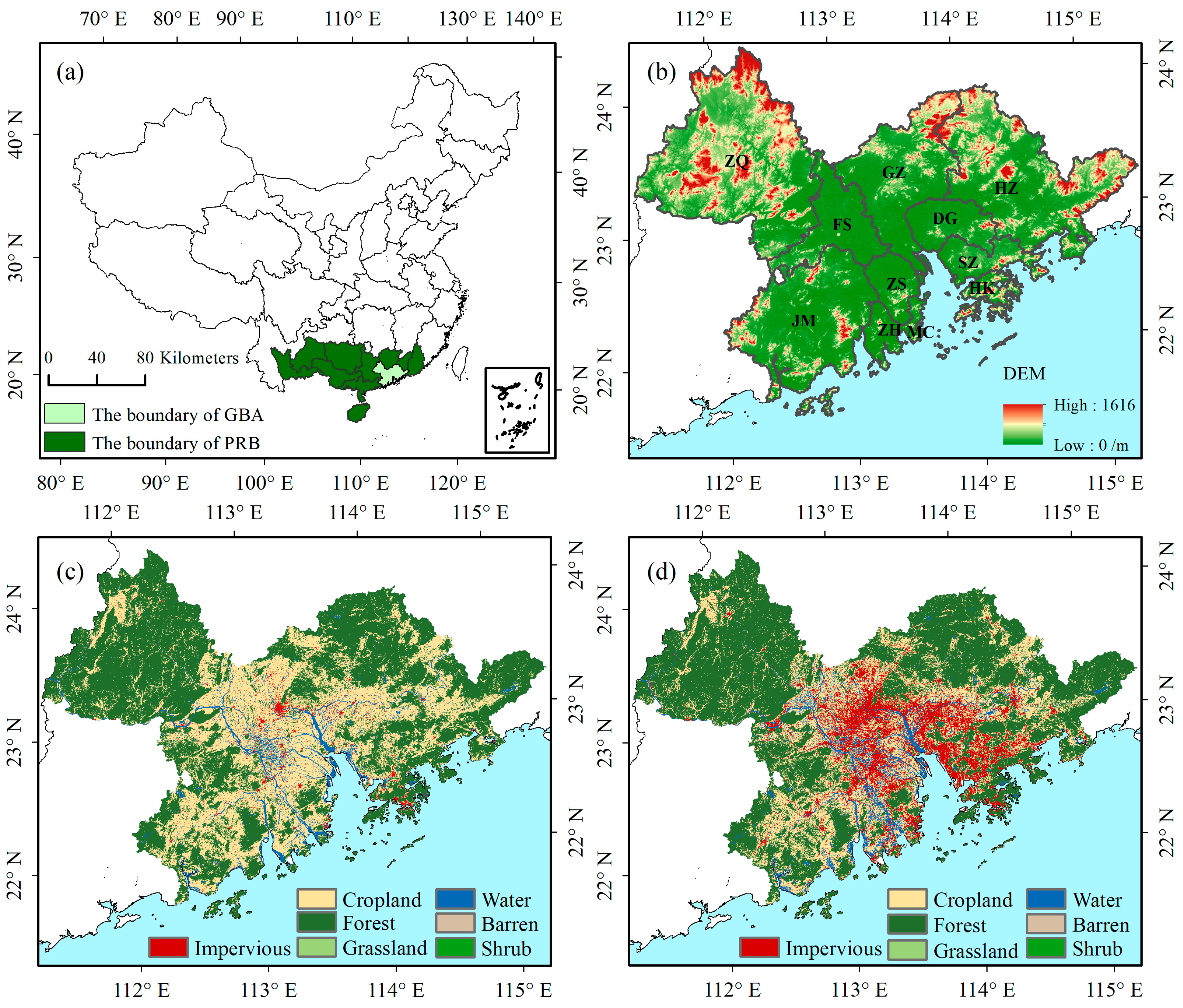

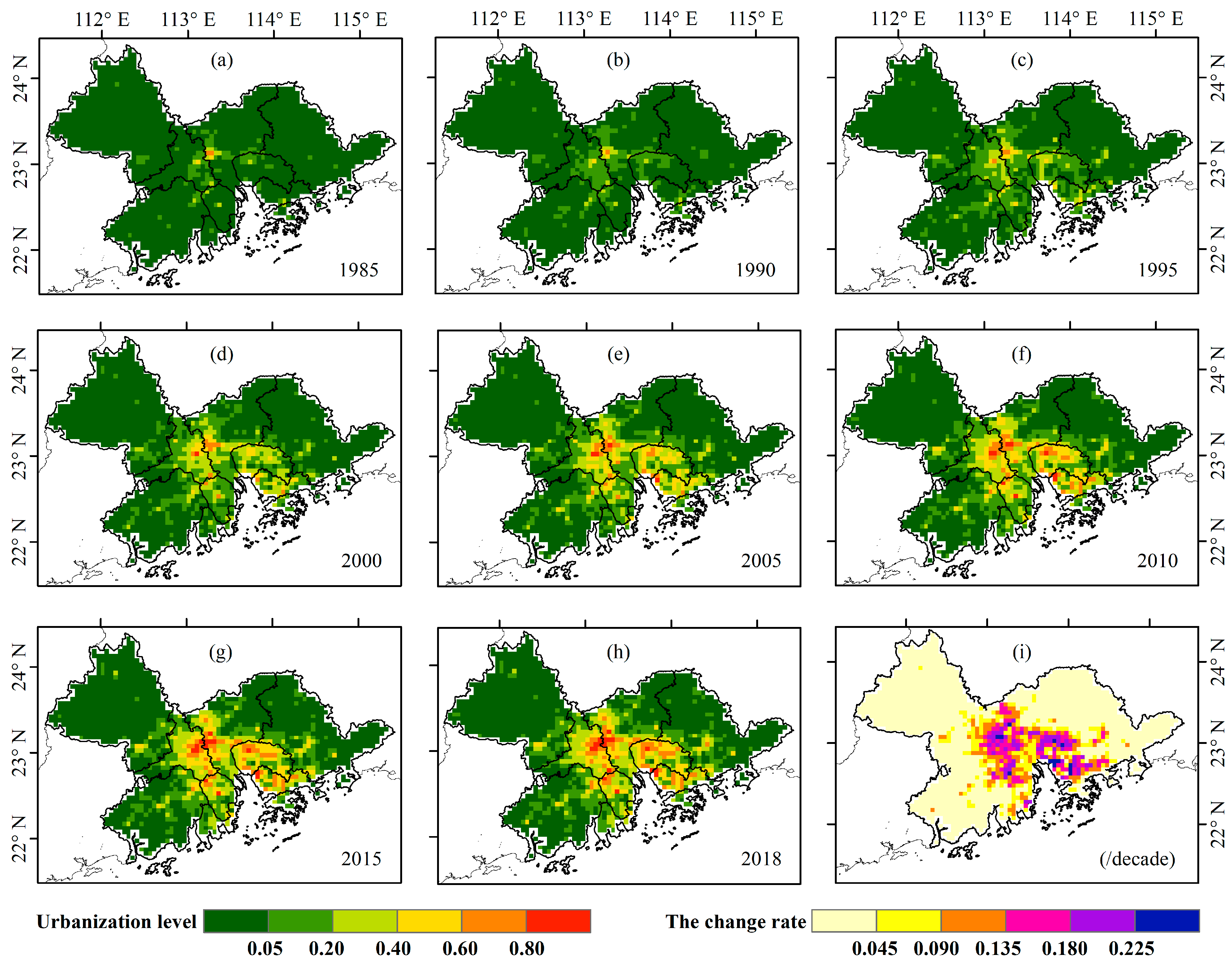
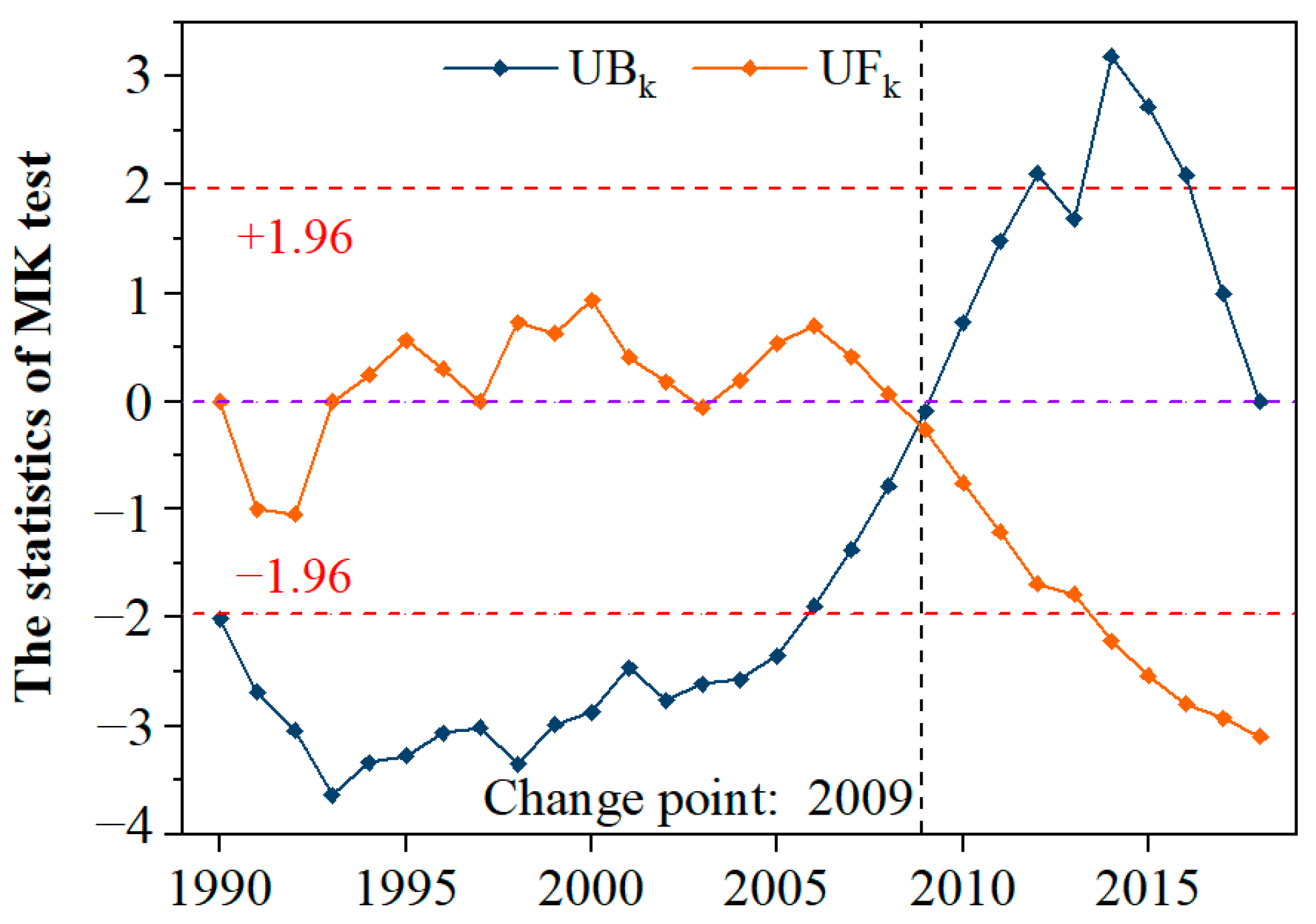
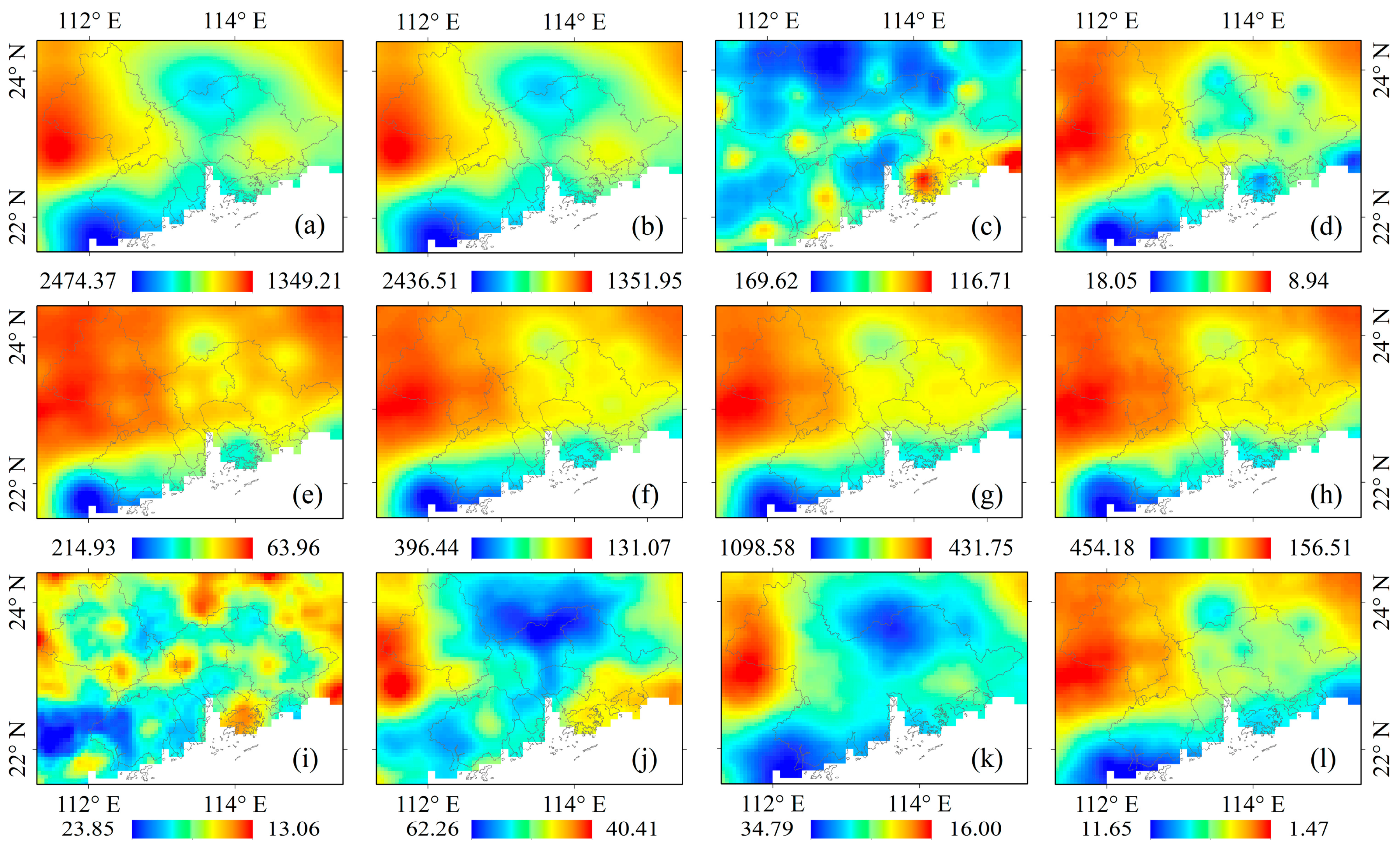

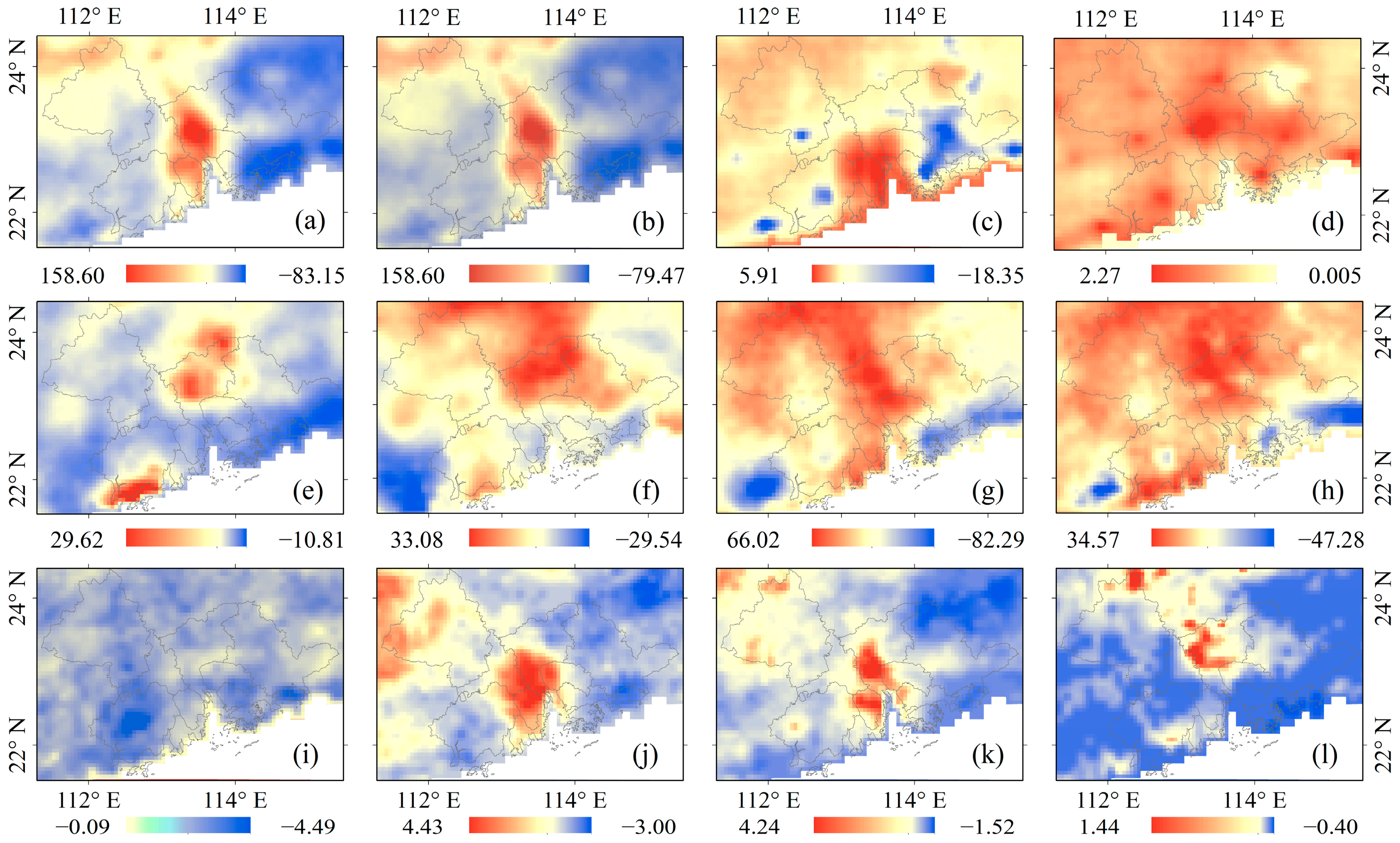
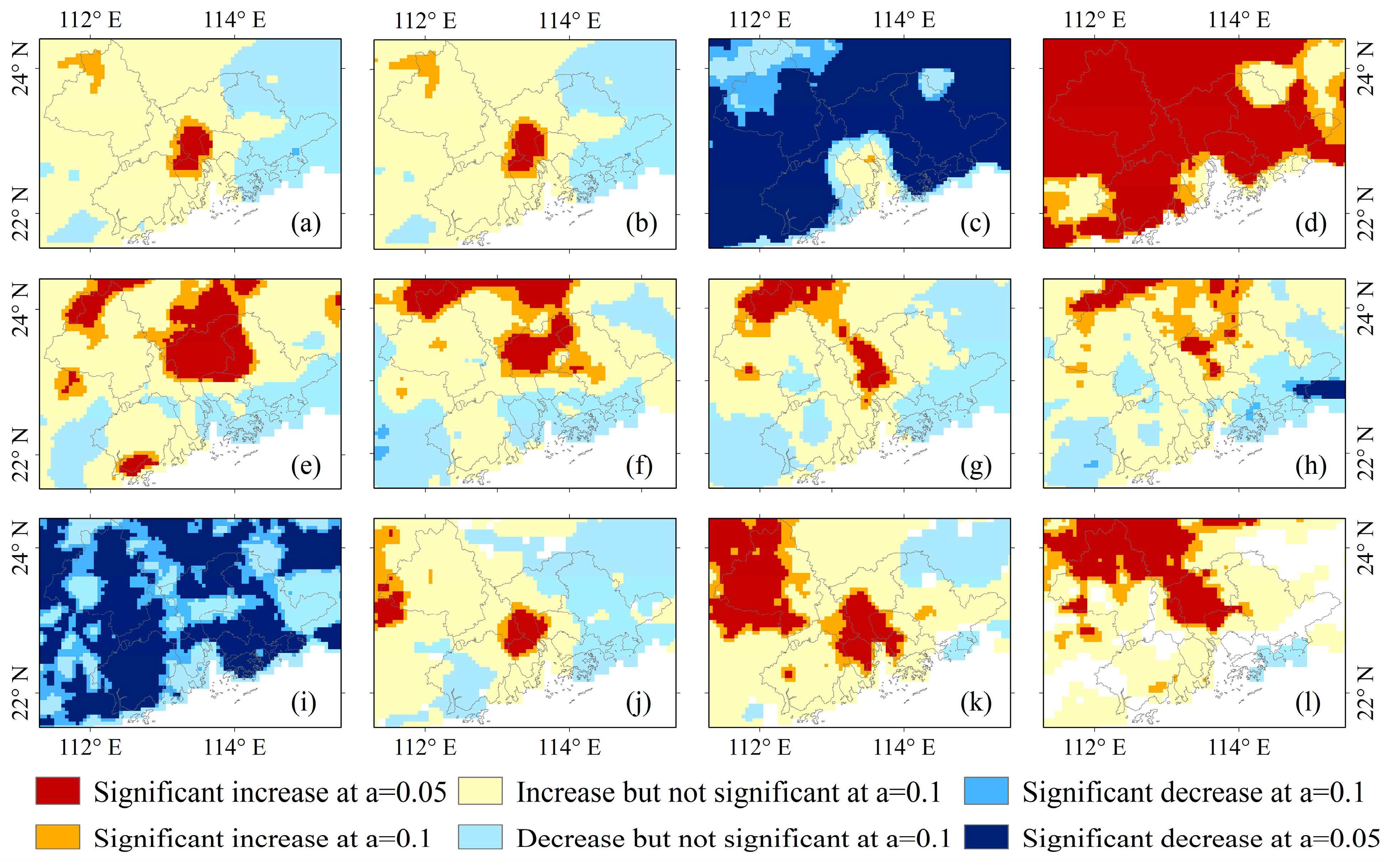

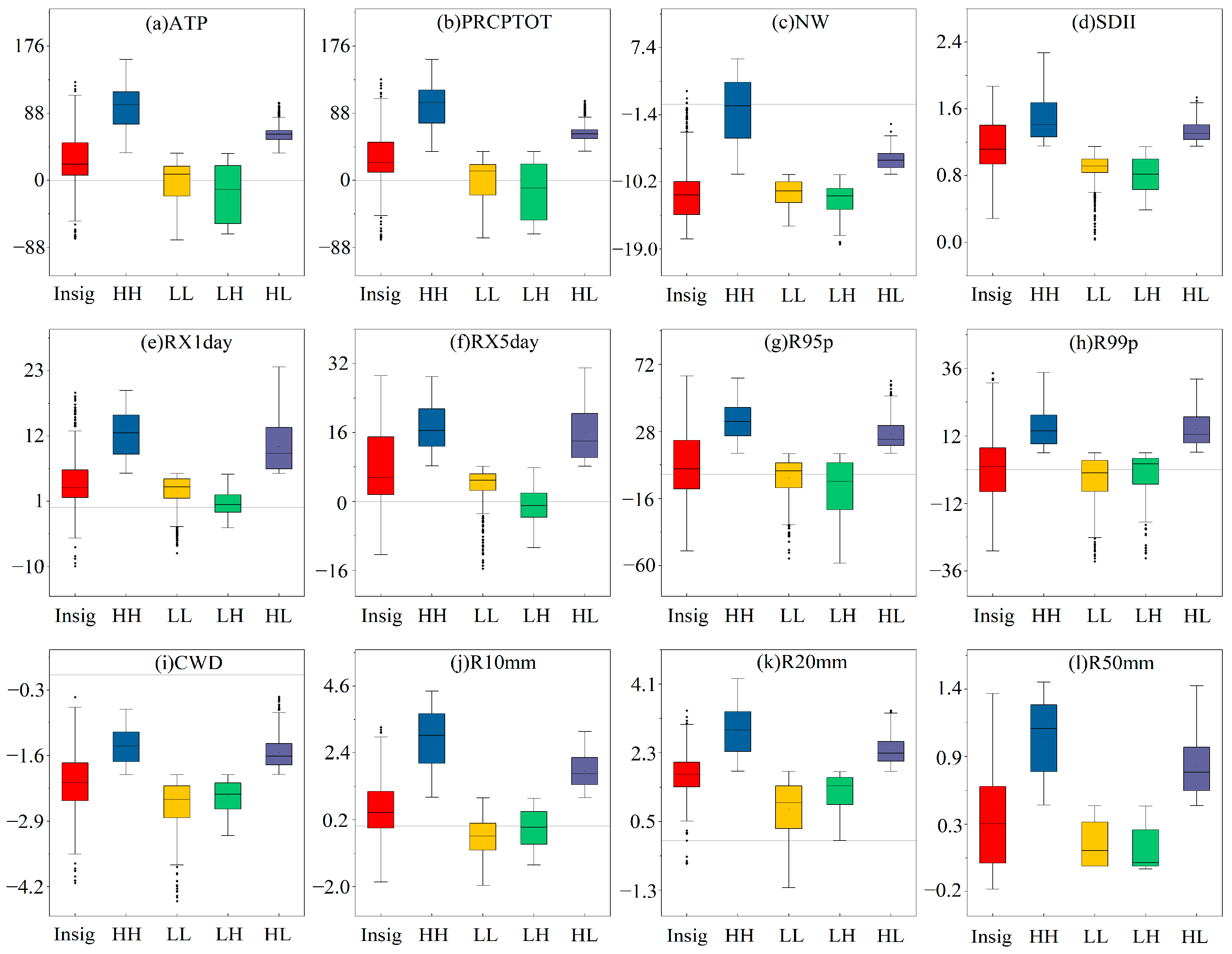
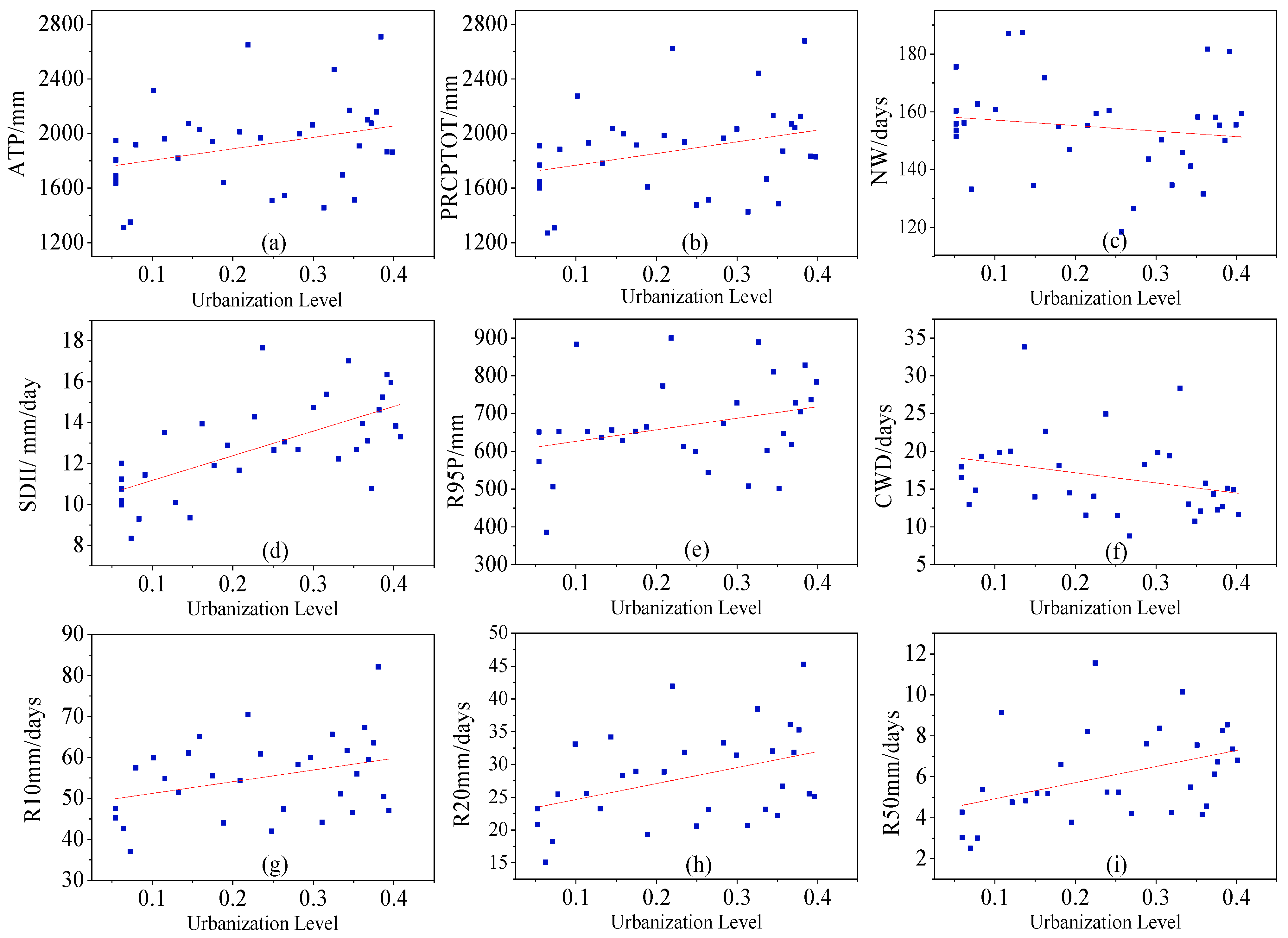
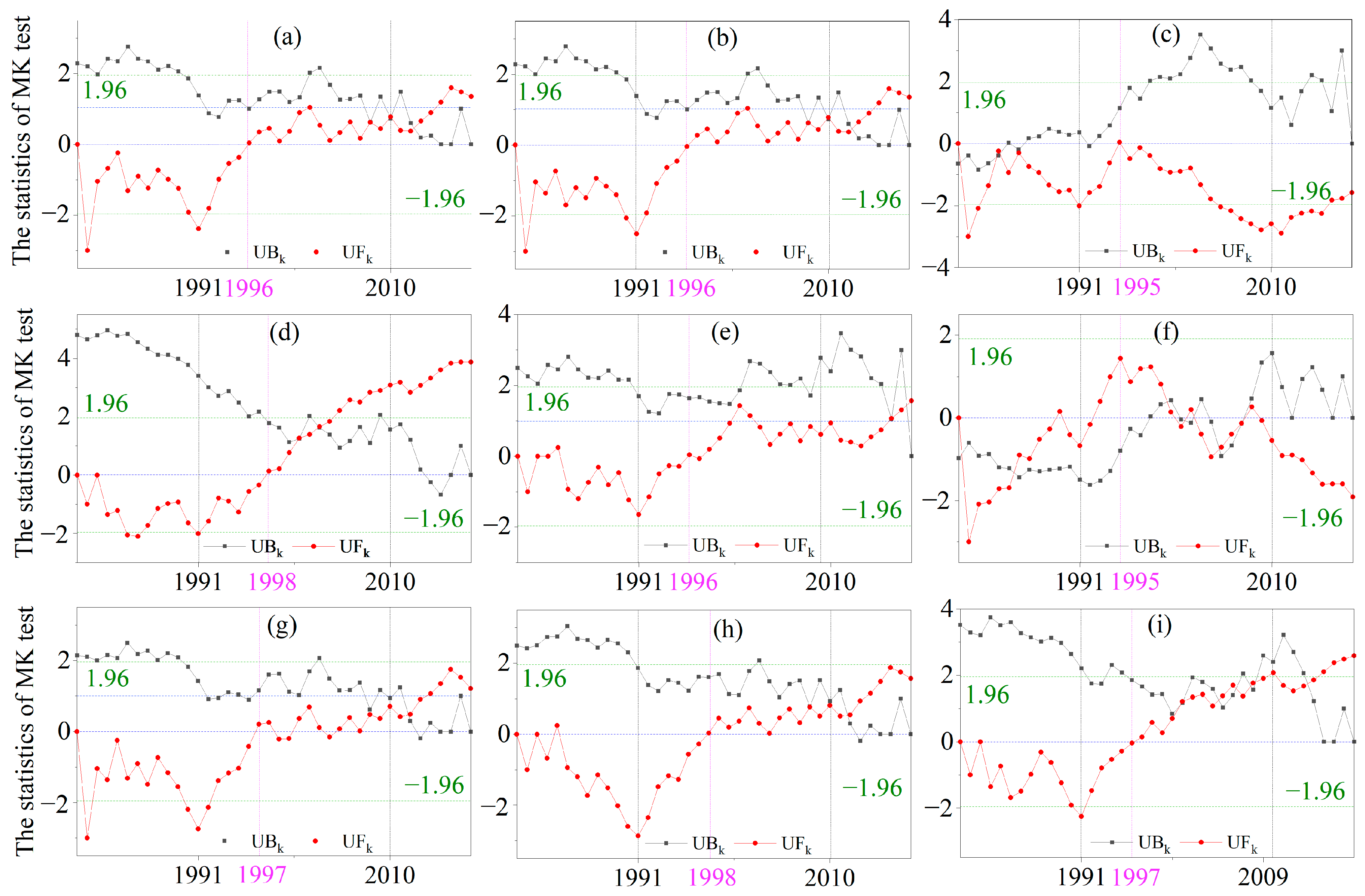
| Index | Descriptive Name | Definition | Units |
|---|---|---|---|
| PRCPTOT | Annual total precipitation | Annual total precipitation in wet days(RR ≥ 1 mm) | mm |
| NW | Wet days | Annual count of days when RR ≥ 1 mm | days |
| SDII | Simple daily intensity index | Average precipitation in wet days | mm/day |
| Rx1 Day | Maximum 1-day precipitation | Annual maximum 1-day precipitation | mm |
| Rx5 Day | Maximum 5-day precipitation | Annual maximum consecutive 5-day precipitation | mm |
| R95P | Very wet day precipitation | Annual total precipitation when RR ≥ 95th percentage | mm |
| R99P | Extreme wet day precipitation | Annual total precipitation when RR ≥ 99th percentage | mm |
| CWD | Consecutive wet days | Maximum number of consecutive wet days | days |
| R10 mm | Heavy precipitation days | Annual count of days when RR ≥ 10 mm | days |
| R20 mm | Very heavy precipitation days | Annual count of days when RR ≥ 20 mm | days |
| R50 mm | Extremely precipitation days | Annual count of days when RR ≥ 50 mm | days |
| Citys | 1985 | 1990 | 1995 | 2000 | 2005 | 2010 | 2015 | 2018 | Change |
|---|---|---|---|---|---|---|---|---|---|
| Foshan | 4.58% | 5.36% | 10.85% | 16.74% | 21.74% | 26.84% | 29.79% | 31.23% | 26.65% |
| Guangzhou | 3.17% | 3.64% | 6.47% | 9.68% | 12.73% | 15.47% | 16.94% | 17.88% | 14.72% |
| Dongguan | 3.77% | 4.66% | 12.36% | 22.30% | 32.44% | 38.51% | 41.47% | 43.28% | 39.51% |
| Zhongshan | 3.07% | 3.62% | 8.68% | 13.79% | 19.61% | 25.06% | 28.38% | 30.73% | 27.66% |
| Shenzhen | 2.55% | 4.00% | 12.00% | 22.23% | 30.31% | 35.29% | 37.35% | 38.43% | 35.88% |
| Huizhou | 0.49% | 0.62% | 1.40% | 2.11% | 2.70% | 3.56% | 4.21% | 4.69% | 4.20% |
| Jiangmen | 1.46% | 1.77% | 2.59% | 3.52% | 4.22% | 5.04% | 5.66% | 6.08% | 4.62% |
| Zhaoqing | 0.69% | 0.74% | 0.95% | 1.30% | 1.52% | 1.84% | 2.11% | 2.31% | 1.62% |
| Zhuhai | 1.76% | 2.16% | 5.02% | 8.27% | 10.67% | 13.78% | 16.51% | 18.38% | 16.62% |
| Hong Kong | 6.47% | 7.25% | 9.13% | 11.15% | 12.08% | 12.54% | 12.86% | 13.09% | 6.62% |
| Macau | 14.99% | 15.95% | 22.73% | 26.96% | 30.11% | 32.82% | 33.81% | 34.38% | 19.40% |
| GBA | 1.80% | 2.14% | 4.14% | 6.45% | 8.49% | 10.31% | 11.41% | 12.10% | 10.30% |
| Index | Moran’s I | p-Value | z-Value | Index | Moran’s I | p-Value | z-Value |
|---|---|---|---|---|---|---|---|
| ATP | 0.335 * | <0.001 | 34.944 | R95P | 0.192 * | <0.001 | 20.721 |
| PRCPTOT | 0.328 * | <0.001 | 34.223 | R99P | −0.014 | 0.05 | −1.577 |
| NW | 0.259 * | <0.001 | 27.452 | CWD | 0.120 * | <0.001 | 12.926 |
| SDII | 0.038 * | <0.001 | 4.194 | R10 mm | 0.415 * | <0.001 | 41.726 |
| Rx1 day | −0.024 | 0.004 | −2.610 | R20 mm | 0.377 * | <0.001 | 38.121 |
| Rx5 day | −0.122 * | <0.001 | −13.018 | R50 mm | 0.087 * | <0.001 | 9.126 |
| Indices | R-Value | p-Value | Indices | R-Value | p-Value |
|---|---|---|---|---|---|
| ATP | 0.312 * | 0.072 | CWD | −0.289 | 0.113 |
| PRCPTOT | 0.319 * | 0.066 | R10 mm | 0.336 * | 0.064 |
| NW | −0.148 | 0.402 | R20 mm | 0.401 ** | 0.025 |
| SDII | 0.661 ** | <0.001 | R50 mm | 0.420 ** | 0.019 |
| R95P | 0.301 * | 0.093 |
| Urbanization Process | Stage 1 | Stage 2-1 (1991–2000) | Stage 2-2 (2001–2009) | Stage 2 (1991–2009) | Stage 3 (2010–2018) | Increase (Stage 2 to Stage 3) |
|---|---|---|---|---|---|---|
| ATP | / | 49.14% | 51.95% | 50.58% | 56.13% | 5.55% |
| PRCPTOT | / | 50.70% | 53.23% | 52.00% | 57.29% | 5.29% |
| SDII | / | 12.30% | 13.42% | 12.84% | 22.28% | 9.44% |
| R95P | / | 38.90% | 40.47% | 39.55% | 53.10% | 13.55% |
| R10 mm | / | 65.07% | 60.42% | 62.89% | 78.06% | 15.17% |
| R20 mm | / | 39.93% | 35.42% | 37.63% | 44.36% | 6.73% |
| R50 mm | / | 11.72% | 23.49% | 15.39% | 20.63% | 5.24% |
Disclaimer/Publisher’s Note: The statements, opinions and data contained in all publications are solely those of the individual author(s) and contributor(s) and not of MDPI and/or the editor(s). MDPI and/or the editor(s) disclaim responsibility for any injury to people or property resulting from any ideas, methods, instructions or products referred to in the content. |
© 2023 by the authors. Licensee MDPI, Basel, Switzerland. This article is an open access article distributed under the terms and conditions of the Creative Commons Attribution (CC BY) license (https://creativecommons.org/licenses/by/4.0/).
Share and Cite
Yang, F.; Wang, X.; Zhou, X.; Wang, Q.; Tan, X. Effects of Urbanization on Changes in Precipitation Extremes in Guangdong-Hong Kong-Macao Greater Bay Area, China. Water 2023, 15, 3438. https://doi.org/10.3390/w15193438
Yang F, Wang X, Zhou X, Wang Q, Tan X. Effects of Urbanization on Changes in Precipitation Extremes in Guangdong-Hong Kong-Macao Greater Bay Area, China. Water. 2023; 15(19):3438. https://doi.org/10.3390/w15193438
Chicago/Turabian StyleYang, Fang, Xinghan Wang, Xiaoxue Zhou, Qiang Wang, and Xuezhi Tan. 2023. "Effects of Urbanization on Changes in Precipitation Extremes in Guangdong-Hong Kong-Macao Greater Bay Area, China" Water 15, no. 19: 3438. https://doi.org/10.3390/w15193438




